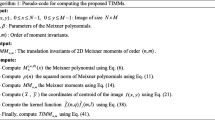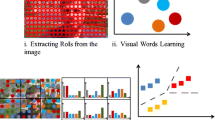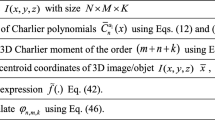Abstract
In this paper, we propose a new method for image classification by the content in heterogeneous databases. This approach is based on the use of new series of separable discrete orthogonal moments as shape descriptors and the Support Vector Machine as classifier. In fact, the proposed descriptors moments are defined from the bivariate discrete orthogonal polynomials of Charlier-Meixner which are invariant to translation, scaling and rotation of the image. We also propose a new algorithm to accelerate the image classification process. This algorithm is based on two steps: the first step is the fast computation of the values of Charlier-Meixner polynomials by using a new recurrence relationship between the values of polynomials Charlier-Meixner. The second one is the new image representation and slice blocks. The proposed method is tested on three different sets of standard data which are well known to computer vision: COIL-100, 256-CALTECH and Corel. The simulation results show the invariance of the discrete orthogonal separable moments of Charlier-Meixner against the various geometric transformations and the ability for the classification of heterogeneous images.













Similar content being viewed by others
References
Abu-Mostafa YS, Psaltis D (1984) Recognitive aspects of moment invariants. IEEE Trans Pattern Anal Mach Intell 6:698–706
Cheng D, Xianglong L, Yadong M (2015) Large-scale multi-task image labeling with adaptive relevance discovery and feature hashing. Signal Process 112:137–145
Chong C-W, Raveendran P, Mukundan R (2003) Translation invariants of Zernike moments. Pattern Recogn 36:1765–1773
Chong C-W, Raveendran P, Mukundan R (2004) Translation and scale invariants of Legendre moments. Pattern Recogn 37:119–129
Dalal N, Triggs B (2005) Histograms of oriented gradients for human detection. Conf Comput Vis Pattern Recognit (CVPR’05) 2:886–893
Dunkl CF, Xu Y (2001) Orthogonal polynomials of several variables. Encyclopedia of mathematics and its applications, vol 81. Cambridge University Press, Cambridge
Fernandez L, Perez TE, Perez MA (2007) Second order partial differential equations for gradients of orthogonal polynomials in two variables. J Comput Appl Math 199:113–121
Fernandez L, Prez TE, Pinar MA (2011) Orthogonal polynomials in two variables as solutions of higher order partial differential equations. J Approx Theory 163:84–97
Flusser J (2000) Refined moment calculation using image block representation. Image Process IEEE Trans 9(11):1977–1978
Garcia C, Delakis M (2004) Convolutional face finder: a neural architecture for fast and robust face detection. IEEE Trans Pattern Anal Mach Intell 26(11):1408–1423
Guyon I, Elisseeff A (2003) An introduction to variable and feature selection. J Mach Learn Res 3:1157–1182
Hmimid A, Sayyouri M, Qjidaa H (2014) Image classification using a new set of separable two-dimensional discrete orthogonal invariant moments. J Electron Imaging 23(1):013026
Hmimid A, Sayyouri M, Qjidaa H (2015) Fast computation of separable two-dimensional discrete invariant moments for image classification. Pattern Recogn 48(2):509–521
Hosny KM (2007) Exact and fast computation of geometric moments for gray level images. Appl Math Comput 189:1214–1222
Hosny KM (2011) Image representation using accurate orthogonal Gegenbauer moments. Pattern Recogn Lett 32:79s5–7804
Hu MK (1962) Visual pattern recognition by moment invariants. IRE Trans Inf Theory IT-8:179–187
Huijun H, Yuanxiang L, Maofu L (2014) Classification of defects in steel strip surface based on multiclass support vector machine. Multimedia Tools Applic 69(1):199–216
Huijun H, Ya L, Maofu L (2016) Surface defect classification in large-scale strip steel image collection via hybrid chromosome genetic algorithm. Neurocomputing 181:86–95
Jie X, Xianglong L, Zhouyuan H (2017) Multi-class support vector machine via maximizing multi-class margins”, In: The 26th International Joint Conference on Artificial Intelligence (IJCAI 2017). https://doi.org/10.24963/ijcai.2017/440
Karakasis EG, Papakostas GA, Koulouriotis DE, Tourassis VD (2013) Generalized dual Hahn moment invariants. Pattern Recogn 46:1998–2014
Khotanzad A, Hong YH (1990) Invariant image recognition by Zernike moments. IEEE Trans Pattern Anal Mach Intell 12:489–497
Koekoek R, Lesky PA, Swarttouw RF (2010) Hypergeometric orthogonal polynomials and their q-analogues. Springer monographs in mathematics. Library of Congress control number: 2010923797
Koornwinder T (1975) Two-variable analogues of the classical orthogonal polynomials. Theory and application of special functions, proceedings of the advanced seminar Madison: University of Wisconsin Press, Academic Press, pp 435–495
Lei H, Xianglong L, Binqiang M (2015) Online semi-supervised annotation via proxy-based local consistency propagation. Neurocomputing 149:1573–1586
Liao SX, Pawlak M (1996) On image analysis by moments. IEEE Trans Pattern Anal Mach Intell 18(3):254–266
Lim C, Honarvar B, Thung KH, Paramesran R (2011) Fast computation of exact Zernike moments using cascaded digital filters. Inf Sci 181:3638–3651
Liu Y, Nie L, Han L, Zhang L, Rosenblum DS (2015) Action 2 Activity: recognizing complex activities from sensor data. In: IJCAI, Buenos Aires, Argentina, pp 1617–1623
Liu Y, Nie L, Han L, Zhang L, Rosenblum DS (2016) From action to activity: sensor-based activity recognition. Neurocomputing 181:108–115
Liu L, Cheng L, Liu Y, Jia Y, Rosenblum DS (2016) Recognizing complex activities by a probabilistic interval-based model. AAAI 30:1266–1272
Liu Y, Zheng Y, Liang Y, Liu S, Rosenblum DS (2016) Urban water quality prediction based on multi-task multi-view learning
Liu Y, Zhang L, Nie L, Yan Y, Rosenblum DS (2016) Fortune teller: predicting your career path. In: AAAI, pp 201–207
Liu M, Zhang L, Hu H (2016) A classification model for semantic entailment recognition with feature combination. Neurocomputing 208:127–135
Liu M, JIAN L, Hu H (2017) Automatic extraction and visualization of semantic relations between medical entities from medicine instructions. Multimedia Tools Applic 76(8):10555–10573
Lowe D (2004) Distinctive image features from scale-invariant keypoints. Int J Comput Vis 60:91–110
Mukundan R, Ong SH, Lee PA (2000) Image analysis by Tchebichef moments. IEEE Trans Image Process 10(9):1357–1364
Nikiforov AF, Suslov SK, Uvarov B (1991) Classical orthogonal polynomials of a discrete variable. Springer, New York
Papakostas GA, Karakasis EG, Koulourisotis DE (2008) Efficient and accurate computation of geometric moments on gray-scale images. Pattern Recogn 41(6):1895–1904
Papakostas GA, Karakasis EG, Koulouriotis DE (March 2010) Accurate and speedy computation of image Legendre moments for computer vision applications. Image Vis Comput 28(3):414–423
D. Preoţiuc-Pietro, Y. Liu,, D. Hopkins and L. Ungar, Beyond binary labels: political ideology prediction of twitter users. Proceedings of the 55th Annual Meeting of the Association for Computational Linguistics, vol. 1, pp 729–740, 2017
Sayyouri M, Hmimd A, Qjidaa H (2012) A fast computation of Charlier moments for binary and gray-scale images. In: Information Science and Technology Colloquium (CIST). CIST, Fez, Morocco, pp 101–105, 22–24
Sayyouri M, Hmimd A, Qjidaa H (2012) A fast computation of hahn moments for binary and gray-scale images. In: IEEE, International Conference on Complex Systems ICCS’12, Agadir, pp. 1–6
Sayyouri M, Hmimd A, Qjidaa H (2012) A fast computation of Charlier moments for binary and gray-scale images. In: The 2nd edition of the IEEE Colloquium on Information Sciences and Technology (CIST’12). CIST, Fez, Morocco
Sayyouri M, Hmimid A, Qjidaa H (2013) Improving the performance of image classification by Hahn moment invariants. J Opt Soc Am A 30:2381–2394
Sayyouri M, Hmimid A, Qjidaa H (2015) A fast computation of novel set of Meixner invariant moments for image analysis. Circ Syst Signal Process Springer 34(3):875–900
Shu HZ, Zhang H, Chen BJ, Haigron P, Luo LM (2010) Fast computation of Tchebichef moments for binary and gray-scale images. IEEE Trans Image Process 19(12):3171–3180
Spiliotis IM, Mertzios BG (1998) Real-time computation of two-dimensional moments on binary images using image block representation. IEEE Trans Image Process 7(11):1609–1615
Teague MR (1980) Image analysis via the general theory of moments. J Opt Soc Amer 70:920–930
Teh CH, Chin RT (1988) On image analysis by the method of moments. IEEE Trans Pattern Anal Mach Intell 10(4):496–513
Tsougenis ED, Papakostas GA, Koulouriotis DE (2014) Image watermarking via separable moments. Multimedia Tools Applic:1–28
Vapnik V (1999) An overview of statistical learning theory. IEEE Trans Neural Netw 10:988–999
Xu Y (2004) On discrete orthogonal polynomials of several variables. Adv Appl Math 33:615–663
Yap PT, Paramesran R, Ong SH (2003) Image analysis by Krawtchouk moments. IEEE Trans Image Process 12(11):1367–1377
Yingjie X, Luming Z, Zhenguang L (2017) Weakly supervised multimodal kernel for categorizing aerial photographs. IEEE Trans Image Process 26(8):3748–3758
Yonggang L, Ye Wei L, Liu J, Letian Z, Ye Liu S (2017) Towards unsupervised physical activity recognition using smartphone accelerometers. Multimedia Tools and Applic 76(8):10701–10719
Yuxing H, Liqiang N (2016) An aerial image recognition framework using discrimination and redundancy quality measure. J Vis Commun Image Represent 37:53–62
Zechao L, Jinhui T (2015) Weakly supervised deep metric learning for community-contributed image retrieval. IEEE Trans Multimedia 17(11):1989–1999
Zechao L, Jinhui T (2017) Weakly supervised deep matrix factorization for social image understanding. IEEE Trans Image Process 26(1):276–288
Zechao L, Jing L, Jinhui T (2015) Robust structured subspace learning for data representation. IEEE Trans Pattern Anal Mach Intell 37(10):2085–2098
Zhang H, Shu HZ, Haigron P, Li BS, Luo LM (2010) Construction of a complete set of orthogonal Fourier–Mellin moment invariants for pattern recognition applications. Image Vis Comput 28:38–44
Zhang L, Yang Y, Wang M (2016) Detecting densely distributed graph patterns for fine-grained image categorization. IEEE Trans Image Process 25(2):553–565
Zhu H (2012) Image representation using separable two-dimensional continuous and discrete orthogonal moments. Pattern Recogn 45(4):1540–1558
Zhu HQ, Shu HZ, Liang J, Luo LM, Coatrieux JL (2007) Image analysis by discrete orthogonal Racah moments. Signal Process 87(4):687–708
Zhu H, Shu H, Xia T, Luo L, Coatrieux JL (2007) Translation and scale invariants of Tchebichef moments. Pattern Recogn 40:2530–2542
Zhu H, Liu M, Shu H, Zhang H, Luo L (2010) General form for obtaining discrete orthogonal moments. IET Image Process 4(5):335–352
Author information
Authors and Affiliations
Corresponding author
Rights and permissions
About this article
Cite this article
Hmimid, A., Sayyouri, M. & Qjidaa, H. Image classification using separable invariant moments of Charlier-Meixner and support vector machine. Multimed Tools Appl 77, 23607–23631 (2018). https://doi.org/10.1007/s11042-018-5623-3
Received:
Revised:
Accepted:
Published:
Issue Date:
DOI: https://doi.org/10.1007/s11042-018-5623-3




